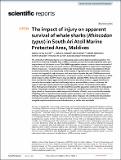The impact of injury on apparent survival of whale sharks (Rhincodon typus) in South Ari Atoll Marine Protected Area, Maldives
Abstract
The whale shark (Rhincodon typus) is an endangered species with a declining global population. The South Ari Atoll Marine Protected Area (SAMPA), Maldives, is one of few locations globally where year-long residency of individuals occurs. This SAMPA aggregation appears to consist almost exclusively of immature males. Due to its year-round residency, this local aggregation is subjected to a high degree of tourism pressure. This ecotourism contributes to the high level of interest and protection offered to whale sharks by the local community. Unfortunately, if regulations are not followed or enforced, tourism can bring with it major stressors, such as accidental injuries. We used POPAN capture-mark-recapture models and lagged identification rate analysis to assess the effect of major injuries on whale shark residency within SAMPA. Injuries may be obtained outside SAMPA. We found individuals with major injuries had a higher apparent survival in the area than those without. Lagged identification rates also demonstrated that sharks with major injuries are more likely to return to the area. We suggest that major injuries result in sharks prolonging their time in the developmental habitat. These findings have implications for individual fitness and the population viability of this endangered species. We propose targeted conservation strategies be considered to protect sharks from further injury. Based on the presented spatio-temporal distributions of sharks, and current local knowledge of sighting patterns, speed limit zones and propeller-exclusion zones should be implemented and enforced. If carried out alongside tourist education, these measures will contribute to the protection of whale sharks within SAMPA and beyond. Furthermore, our results can aid research direction, alongside regulation and enforcement development, at similar sites worldwide.
Citation
Harvey-Carroll , J , Stewart , J D , Carroll , D , Mohamed , B , Shameel , I , Zareer , I H , Araujo , G & Rees , R 2021 , ' The impact of injury on apparent survival of whale sharks ( Rhincodon typus ) in South Ari Atoll Marine Protected Area, Maldives ' , Scientific Reports , vol. 11 , 937 . https://doi.org/10.1038/s41598-020-79101-8
Publication
Scientific Reports
Status
Peer reviewed
ISSN
2045-2322Type
Journal article
Collections
Items in the St Andrews Research Repository are protected by copyright, with all rights reserved, unless otherwise indicated.

